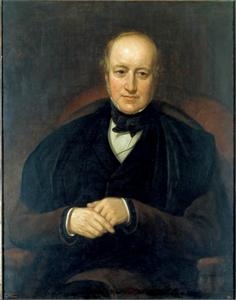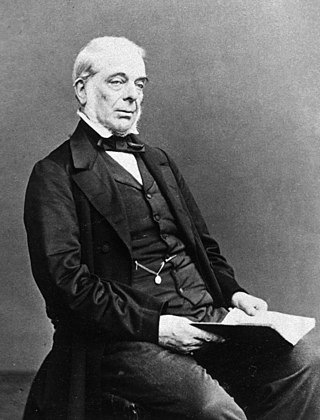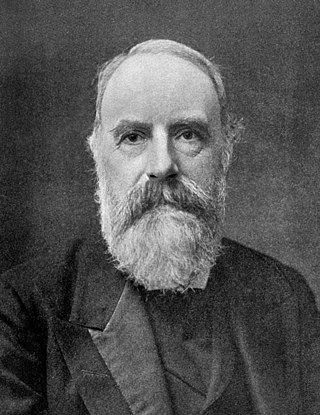
Peter Mark Roget was a British physician, natural theologian, lexicographer, and founding secretary of The Portico Library. He is best known for publishing, in 1852, the Thesaurus of English Words and Phrases, a classified collection of related words (thesaurus). He also read a paper to the Royal Society about a peculiar optical illusion in 1824, which is often regarded as the origin of the persistence of vision theory that was later commonly used to explain apparent motion in film and animation.
The Royal Medical and Chirurgical Society of London (RMCS), created in 1805 as the Medical and Chirurgical Society of London, was a learned society of physicians and surgeons, that received a Royal charter in 1834, and a supplement charter in 1907 to create the newly merged Royal Society of Medicine.

Joseph Hodgson (1788–1869) was a British physician and a well-known Quaker. He was born in Penrith, Cumberland, the son of a Birmingham merchant and educated at King Edward VI School, Birmingham, after which he was apprenticed to George Freer at Birmingham General Hospital. He then transferred to St. Bartholomew's Hospital, London.

John Elliotson, M.D., M.D.(Oxford, 1821), F.R.C.P.(London, 1822), F.R.S. (1829), professor of the principles and practice of medicine at University College London (1832), senior physician to University College Hospital (1834) — and, in concert with William Collins Engledue M.D., the co-editor of The Zoist.

The Royal Society of Medicine (RSM) is a medical society based at 1 Wimpole Street, London, UK. It is a registered charity, with admission through membership.
The Journal of the Royal Society of Medicine is a peer-reviewed medical journal. It is the flagship journal of the Royal Society of Medicine with full editorial independence. Its continuous publication history dates back to 1809. Since July 2005 the editor-in-chief is Kamran Abbasi, who succeeded Robin Fox who was editor for almost 10 years.

Richard Partridge FRS, FRCS was a British surgeon. Although he became President of both the Royal College of Surgeons and the Royal Medical and Chirurgical Society, he is best known for his part in apprehending the London Burkers gang and for failing to spot a bullet lodged in Giuseppe Garibaldi's leg.

The Medical Society of London is one of the oldest surviving medical societies in the United Kingdom.

Sir Norman Moore, 1st Baronet, FRCP was a British doctor and historian, best known for his work with the Royal College of Physicians and his writings on history of medicine. Born in Higher Broughton, Salford, Lancashire, the only child of abolitionist and social reformer Rebecca Moore, née Fisher, of Limerick and the noted Irish political economist Robert Ross Rowan Moore, Moore worked in a cotton mill before studying natural sciences in Cambridge and then going on to study comparative anatomy at St Bartholomew's Hospital.

William Senhouse Kirkes was an English physiologist noted for his reference work "Kirkes' Physiology" which first appeared in 1848.
The Pathological Society of London was founded in 1846 for the "cultivation and promotion of pathology by the exhibition and description of specimens, drawings, microscopic preparations, casts or models of morbid parts."

Robert Dunn was a British surgeon.
The Clinical Society of London was founded in London in 1868 and merged in 1907 with the Royal Medical and Chirurgical Society of London to form the Royal Society of Medicine (RSM).

Sir William Selby Church, 1st Baronet, was a British physician to St Bartholomew's Hospital, president of the Royal College of Physicians from 1899 to 1905 and president of the Royal Society of Medicine from 1907 to 1909 and also in 1893. He is best remembered for his ability to direct policy of the associations he belonged to.

Thomas Turner, FRCS, FLS, was an English surgeon known primarily for his involvement in developing medical education outside its then traditional base of London. He established a medical school in Manchester and was both a Fellow of the Royal College of Surgeons of England and the Linnean Society of London.
Gavin Milroy (1805–1886) was a Scottish physician and medical writer.

William Saunders FRS FRSE was a Scottish physician who was the first president of the Royal Medical and Chirurgical Society.

Timothy Holmes FRCS was an English surgeon, known as the editor of several editions of Gray's Anatomy.

David Hodgson was a professional English painter of landscapes and an active member of the Norwich School of painters. He was the son of the amateur artist Charles Hodgson, whom he accompanied on a tour of Wales in 1805, when he was seven. He was taught art by John Crome at Norwich Grammar School.

The Fitzpatrick Lecture is given annually at the Royal College of Physicians on a subject related to history of medicine. The lecturer, who must be a fellow of the college, is selected by the president and may be chosen to speak for two years successively. The lectures are supported by funds from the Fitzpatrick Trust which was established in 1901 by Agnes Letitia Fitzpatrick with a £2,000 donation in memory of her physician husband Thomas Fitzpatrick. Agnes was influenced by her husband's close friend, Sir Norman Moore, who persuaded her to choose history of medicine as a subject. Subsequently, Moore was credited with its idea and implementation.



















